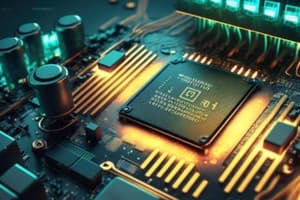Podcast
Questions and Answers
Which of the following best describes computer architecture?
Which of the following best describes computer architecture?
- The design of computers including instruction sets and hardware components (correct)
- The operating systems that manage computer hardware
- The physical components of a computer system
- The specific programming languages used for software development
Computer organization and computer architecture refer to the same concept.
Computer organization and computer architecture refer to the same concept.
False (B)
What is one example of an architectural attribute of a computer system?
What is one example of an architectural attribute of a computer system?
Instruction set
Computer organization refers to the __________ relationship and operational units that realize architectural specifications.
Computer organization refers to the __________ relationship and operational units that realize architectural specifications.
Match the following components with their description:
Match the following components with their description:
What is NOT a component that is part of the general structure of a digital computer?
What is NOT a component that is part of the general structure of a digital computer?
A memory cell can store more than one bit of data.
A memory cell can store more than one bit of data.
What type of logical function does a gate implement?
What type of logical function does a gate implement?
The earliest integrated circuits are known as ___ because they contained only a few gates or memory cells.
The earliest integrated circuits are known as ___ because they contained only a few gates or memory cells.
Match the following components of a computer to their functions:
Match the following components of a computer to their functions:
What is the primary focus of computer architecture?
What is the primary focus of computer architecture?
What type of data processing is provided by gates?
What type of data processing is provided by gates?
Computer organization deals with the functional behavior of computer systems.
Computer organization deals with the functional behavior of computer systems.
Integrated circuits can include both gates and memory cells.
Integrated circuits can include both gates and memory cells.
What defines whether a computer has a multiply instruction?
What defines whether a computer has a multiply instruction?
What is the role of the control unit in a digital computer?
What is the role of the control unit in a digital computer?
Computer Organization consists of physical units like __________.
Computer Organization consists of physical units like __________.
Which of the following is a category of computer architecture?
Which of the following is a category of computer architecture?
Match the computer organization types with their descriptions:
Match the computer organization types with their descriptions:
Which decision is an organizational issue regarding the multiply instruction?
Which decision is an organizational issue regarding the multiply instruction?
What is a prerequisite course for understanding computer organization and architecture?
What is a prerequisite course for understanding computer organization and architecture?
Flashcards
Computer Architecture
Computer Architecture
The functional behavior of a computer system, defined by instructions, addressing modes, and logical functions.
Computer Organization
Computer Organization
The structural relationship within a computer system, including circuit designs, peripherals, and implementation details, describing 'how' the computer performs tasks.
Von-Neumann Architecture
Von-Neumann Architecture
A computer architecture with a single address space for both instructions and data.
Harvard Architecture
Harvard Architecture
Signup and view all the flashcards
Instruction Set Architecture (ISA)
Instruction Set Architecture (ISA)
Signup and view all the flashcards
Micro-architecture
Micro-architecture
Signup and view all the flashcards
CPU Organization
CPU Organization
Signup and view all the flashcards
Architecture vs. Organization
Architecture vs. Organization
Signup and view all the flashcards
Architectural Attribute
Architectural Attribute
Signup and view all the flashcards
Organizational Attribute
Organizational Attribute
Signup and view all the flashcards
Digital Computer Structure
Digital Computer Structure
Signup and view all the flashcards
Gate
Gate
Signup and view all the flashcards
Memory Cell
Memory Cell
Signup and view all the flashcards
Integrated Circuit (IC)
Integrated Circuit (IC)
Signup and view all the flashcards
Small-Scale Integration (SSI)
Small-Scale Integration (SSI)
Signup and view all the flashcards
Arithmetic Logic Unit
Arithmetic Logic Unit
Signup and view all the flashcards
Control Unit
Control Unit
Signup and view all the flashcards
Data Processing
Data Processing
Signup and view all the flashcards
Study Notes
Computer Organization and Architecture
- Focuses on how a computer functions systematically
- Aims to derive solutions for any problem using a systematic approach
- Studies different aspects to create a complete picture, covering architecture and organization
Lecture 1 Topics
- Computer Architecture: Defines the functional behavior of a computer system, including design, instruction sets, hardware components, and system organization, from a programmer's perspective
- Architectural Attributes: Specific aspects influencing program execution logic, like instruction sets, data types (e.g., numbers, characters) representation in bits, input/output (I/O) mechanisms, and memory addressing techniques
- Von Neumann Architecture: A computer design with a central processing unit (CPU), including a control unit and arithmetic logic unit (ALU), and a memory unit, as well as input and output devices
- Computer Organization: Details the structural relationships between various units and their interconnections, hardware details that programmers don't need to know, such as control signals, interfaces between the computer and peripherals, and memory structures
- Example Architectural Design Issue: Deciding whether a computer will include a multiply instruction and how that instruction will be implemented (e.g., dedicated multiply unit or repeated use of add unit). This decision is based on factors like frequency of use, relative speed of approaches, and cost/size of special hardware
Syllabus
- Provides a comprehensive outline for the course, including topics like introduction to computer organization and architecture, register transfer, microoperations, computer memory, programming basic computers, microprogrammed control, microprocessors, microcontrollers, pipeline, and vector processing
Prerequisite Course
- Digital Logic Design: The required prior knowledge for this course.
Computer Architecture vs. Computer Organization
- Architecture: Describes what a computer does, focusing on the functional behavior and characteristics visible to programmers. It's the design of the computer function
- Organization: Describes how the computer does it, focusing on the structural aspects, interconnections, and hardware details. It's the implementation detail of the function
Structure and Function
-
Structure: Describes the way components are interconnected within a computer system. Complex (modern) computers contain many interconnected electronic components.
-
Function: Refers to the operation of each component working together as part of the overall structure. Both structure and function are simple in essence. Functional diagrams illustrate how data is processed, stored, moved, and managed within a computer
-
Data Processing: The computer needs to process data. Data can be in various forms.
-
Data Storage: A computer needs to store data temporarily, even during processing.
-
Data Movement: Data moves internally as well as between a computer and the outside world
-
Control: A control unit manages the above three functions by responding to instructions from the user or another part of the system
-
Peripheral Devices: External devices that interface with a computer, such as keyboards or printers.
-
Communication Lines: Channels for data movement between computers or between a computer and other systems
Internal Structure of a Computer
- Central Processing Unit (CPU): The primary component for processing data and executing instructions
- Main Memory: Stores data and instructions that the CPU needs
- Input/Output (I/O): Interfaces with outside devices, moving data in and out of the computer
- System Interconnection: The mechanism enabling communication between the CPU, main memory, and I/O devices
Computer System Level Hierarchy
- Levels 0-6: A seven-level structure depicting different abstraction layers in a computer system. Users interact at the highest level (Level 6) with executable programs. Lower levels (0-5) represent increasingly detailed operational components, like digital logic, control units, assembly, and high-level programming languages.
Computer Evolution and Performance
- Describes the history and development of computer systems, linking to how their performance has improved over time.
Digital Computer
- Main Memory: Stores data and instruction sets
- ALU (Arithmetic Logic Unit): Performs calculations on binary data
- Control Unit: Interprets and executes instructions from memory
- I/O (Input/Output) Equipment: Handles input and output operations
Digital Computer (Gate & Memory components)
- Gate: Basic building block (circuit) implementing Boolean logic functions
- Memory: Storage for a bit of data from the memory cells, capable of two states
- Connections among elements: Enables data flow and operations in the computer that are constructed from digital components.
Gates in Integrated Circuits
- ICs: (Integrated Circuits) combine many gates (logic circuits) and memory cells on one chip
- Packaging: Components are packaged to improve protection, handling, and interconnections
- Interconnections: Combine multiple components for more complex behavior
Logic Gates
- AND, OR, NOT (inverter), buffer: Basic logic gates showing the different operations performed on binary information
Boolean Algebra
- Deals with binary variables (0 or 1) and logic operations.
- Useful to analyze and design digital circuits, allowing for the expression of boolean functions as algebraic equations or truth tables, leading to simplified circuit designs.
Map Simplification: K-maps
- Helpful method for simplifying Boolean functions.
- Provides a systematic procedure for simplifying and condensing Boolean functions using a visual map, often reducing the required components and complexity.
- Min-terms: Each combination of variables and possible outputs in a truth table
- Don't-Care conditions: Allow variations when simplifying functions, leading to more compact designs.
Studying That Suits You
Use AI to generate personalized quizzes and flashcards to suit your learning preferences.




